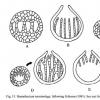
26-12-2025 21:19
Arnold BüschlenPithyella challaudii Pirou. Ist als Bryoparasit in

24-12-2025 17:08
Hulda Caroline HolteHello, I have found this propoloid ascomycete on

21-12-2025 09:32
Hello.A tiny ascomycete found embedded in wood in

21-12-2025 21:32
Pol DebaenstHello, Garden, Burgweg 19, Veurne, BelgiumOn 10/1

22-12-2025 23:38
Patrice TANCHAUDBonsoir, récolte sur un mur en pierre, apothéci
The meaning of "trabeculate"
Björn Wergen,
28-01-2014 22:17
 Hi friends,
Hi friends,I have one question: what does the word "trabeculate" mean? Its mostly used to describe paraphyses/pseudoparaphyses. I have problems to decide whether the paraphyses are trabeculate or not...
In latin, trabecula means "beam". I think it could be the connections between the paraphyses/pseudoparaphyses?
Thanks in advance!
regards,
björn
Chris Yeates,
28-01-2014 23:51

Re : The meaning of "trabeculate"
From Dictionary of the Fungi:
"Hamathecium (Eriksson, Opera Bot. 60: 15, 1981), a neutral term for all kinds of hyphae or other tissues between asci, or projecting into the locule or ostiole of ascomata; usually of carpocentral origin; interascal tissues. Eriksson recognized seven categories (see Fig. 14A-F - below):
(A) Interascal pseudoparenchyma, carpocentral tissues unchanged or compressed between developing asci; e.g. Wettsteinina.
(B) Paraphyses, hyphae originating from the base of the cavity, usually unbranched and not anastomosed; e.g. Pyrenula, Xylaria.
(C) Paraphysoids (trabecular pseudoparaphyses; tinophyses), interascal or pre-ascal tissue stretching and coming to resemble pseudoparaphyses; often only remotely septate, anastomosing and very narrow (see Barr, Mycol. 71: 935, 1979); e.g. Patellaria, Melanomma.
. . . . . . . . "
regards
Chris
"Hamathecium (Eriksson, Opera Bot. 60: 15, 1981), a neutral term for all kinds of hyphae or other tissues between asci, or projecting into the locule or ostiole of ascomata; usually of carpocentral origin; interascal tissues. Eriksson recognized seven categories (see Fig. 14A-F - below):
(A) Interascal pseudoparenchyma, carpocentral tissues unchanged or compressed between developing asci; e.g. Wettsteinina.
(B) Paraphyses, hyphae originating from the base of the cavity, usually unbranched and not anastomosed; e.g. Pyrenula, Xylaria.
(C) Paraphysoids (trabecular pseudoparaphyses; tinophyses), interascal or pre-ascal tissue stretching and coming to resemble pseudoparaphyses; often only remotely septate, anastomosing and very narrow (see Barr, Mycol. 71: 935, 1979); e.g. Patellaria, Melanomma.
. . . . . . . . "
regards
Chris
